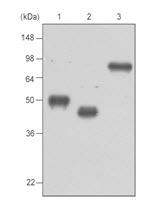
Recombinant protein MBP-tagged BCDEF, TPD52 and MAGEA3(each 20ng) were resolved by SDS-PAGE, transferred to PVDF membrane and probed with anti-MBP (1:1,000). Proteins were visualized using a goat anti-mouse secondary antibody conjugated to HRP and an ECL
Maltose binding protein antibody [10C12]
GTX50060
Overview
- SupplierGeneTex
- Product NameMaltose binding protein antibody [10C12]
- Delivery Days Customer9
- Application Supplier NoteWe recommend the following starting dilutions:WB-Ag: Use at 1:1,000 ~ 2,000.Optimal working concentrations should be determined experimentally by the end user.
- ApplicationsWestern Blot, ELISA
- CertificationResearch Use Only
- ClonalityMonoclonal
- Clone ID10C12
- Concentration1 mg/ml
- ConjugateUnconjugated
- Gene ID4155
- Target nameMBP
- Target descriptionmyelin basic protein
- Target synonymsGolli-MBP; myelin A1 protein; myelin basic protein; myelin membrane encephalitogenic protein; proline-rich proteoglycan 2
- HostMouse
- IsotypeIgG1
- Protein IDP02686
- Protein NameMyelin basic protein
- Scientific DescriptionThe protein encoded by the classic MBP gene is a major constituent of the myelin sheath of oligodendrocytes and Schwann cells in the nervous system. However, MBP-related transcripts are also present in the bone marrow and the immune system. These mRNAs arise from the long MBP gene (otherwise called Golli-MBP) that contains 3 additional exons located upstream of the classic MBP exons. Alternative splicing from the Golli and the MBP transcription start sites gives rise to 2 sets of MBP-related transcripts and gene products. The Golli mRNAs contain 3 exons unique to Golli-MBP, spliced in-frame to 1 or more MBP exons. They encode hybrid proteins that have N-terminal Golli aa sequence linked to MBP aa sequence. The second family of transcripts contain only MBP exons and produce the well characterized myelin basic proteins. This complex gene structure is conserved among species suggesting that the MBP transcription unit is an integral part of the Golli transcription unit and that this arrangement is important for the function and/or regulation of these genes. [provided by RefSeq, Jul 2008]
- ReactivityBacteria
- Storage Instruction-20°C or -80°C,2°C to 8°C
- UNSPSC12352203
References
- MRI Is a DNA Damage Response Adaptor during Classical Non-homologous End Joining. Hung PJ et al., 2018 Jul 19, Mol CellRead more
